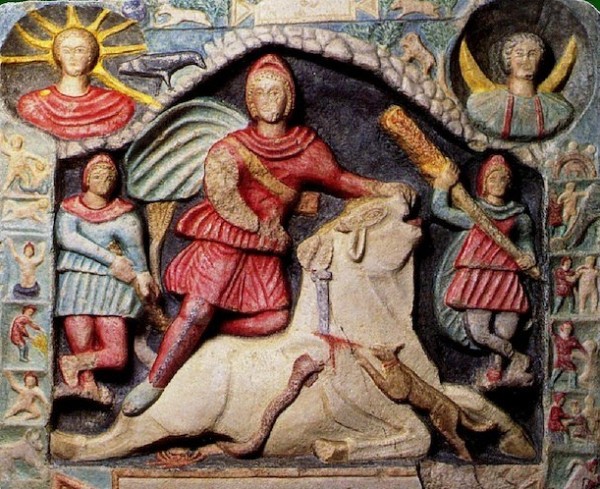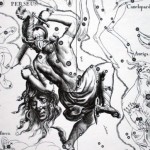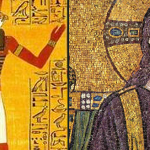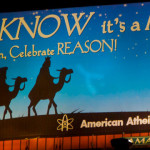Exploding the Mithras Myth
by Jon Sorensen
Filed under Historicity
In an effort to cast doubt on Christianity, skeptics will attempt to point out parallels between the beliefs and practices of Christians to those of the Roman cult of Mithras. In this article we will examine the most commonly encountered parallels and answer their claims.
Lists of parallels can be found in skeptic literature or by searching the Internet and they usually appear as follows:
- Mithras preceded Christianity by roughly 600 years.
- Mithras was born on December 25.
- He was considered a great teacher and had twelve disciples.
- Mithras also performed miracles.
- Mithras was called “the good shepherd,” “the way, the truth and the light,” “redeemer,” “savior,” and “messiah.”
- He was identified with the lion and the lamb.
- He was buried in a tomb and after three days he rose again and his resurrection was celebrated every year.
- Mithraism had a Eucharist or “Lord’s Supper” that involved consecrated bread and wine.
- Their initiation ceremonies included a baptism to remove sins.
Who was Mithras?
Worship of the god Mithras became popular among Roman soldiers at its peak in the second and third centuries. Much of what we know about this religion comes from ancient reliefs and other sculptures. Because no written documents defining the mythology and ritual beliefs of Mithraism exist, scholars can only do their best to interpret the elements pictured in the surviving artwork.
The basic myth begins with Mithras being born when he emerged from a rock. In this scene he is most often depicted as a youth, carrying a torch, a dagger, and wearing a soft cone-shaped cap with the top pulled forward (also known as a Phrygian cap). The most popular image of Mithras depicts him slaying a bull; thought to be the first act of creation (Manfred Claus, The Roman Cult of Mithras, p. 81).
Does Mithraism predate Christianity?
Prior to the first century A.D., belief in a Zoroastrian divinity named Mitra was common among the ancient Persians. “Mitra (or miθra in the Old Iranian dialect of Avestan) means treaty or contract. Mitra was believed to be treaty and contract personified” (Claus, p. 3).
The most popular hypothesis holds that Roman soldiers encountered this religion during military excursions to areas known today as Iran and Iraq. For many years scholars believed that the Roman mystery cult was based on the ancient Persian god, thus predating Christianity. This assumption begins with early twentieth-century Belgian archaeologist and historian Franz Cumont (cf. Cumont’s book The Mysteries of Mithra).
While Cumont’s work is regarded as pioneering in the field, many recent scholars have challenged his assumption. According to John Hinnells at the First International Congress of Mithraic Studies held in 1971, “We must now conclude that [Cumont’s] reconstruction simply will not stand. It receives no support from the Iranian material and is in fact in conflict with the ideas of that tradition as they are represented in the extant texts. Above all, it is a theoretical reconstruction which does not accord with the actual Roman iconography” (John R. Hinnells, Mithraic Studies, vol. 2, “Reflections on the bull-slaying scene”).
Manfred Claus, a professor of ancient history at the Free University of Berlin, also supports this position: “The mysteries cannot be shown to have developed from Persian religious ideas, nor does it make sense to interpret them as a forerunner of Christianity” (The Roman Cult of Mithras, p. 7).
Was Mithras born on December 25?
According to inscriptions on candle votives and other works of art found in Mithraeum, there is a link between Mithras and the Roman sun god Sol Invictus (Unconquered Sun). In some cases it appears the Mithraists believed that Mithras and Sol were manifestations of the same god. In others they appear to be two gods united as one. And in yet others they appear to be two distinct gods. These connections are difficult to understand given our limited knowledge of the belief system, but they are important because they help to explain why the birthday of Mithras was celebrated on December 25.
In A.D. 274, the Roman Emperor Aurelian gave the cult of Sol Invictus official status alongside the other traditional cults of the Empire. According to a manuscript known as the Chronography of 354, the birth of Sol Invictus was celebrated on December 25. Given the fact that the Mithraists equated their god with Sol in one way or another, it is understandable that they would then appropriate the established date as their own.
The problem for the skeptic is that no evidence exists to suggest that Aurelian was a Mithraist, or that he even had Mithraism in mind when he instituted the feast of Sol Invictus. The date of the festival became important to the Mithraists because they equated their god with Sol.
Another interesting fact about the Chronography of 354 is that it is the earliest mention of the feast of Sol Invictus being celebrated on December 25. Coincidentally, the celebration of the birth of Christ by Christians is also mentioned as having been on that day. Pope Benedict XVI comments on this before he became pope:
"The claim used to be made that December 25 developed in opposition to the Mithras myth, or as a Christian response to the cult of the unconquered sun promoted by Roman emperors in the third century in their efforts to establish a new imperial religion. However, these old theories can no longer be sustained. The decisive factor was the connection of creation and Cross, of creation and Christ’s conception." (Joseph Ratzinger; The Spirit of the Liturgy, p. 107)
As Pope Benedict points out, the Christians came to date Christ’s birth on December 25 based on a belief that his conception and Passion were thought to have occurred on the same day of the year (The Spirit of the Liturgy, pp.105-107). There is no evidence that there was any attempt by the Christian community to “baptize” a pagan celebration.
Was Mithras considered a great teacher who had twelve disciples?
It is a stretch to claim that Mithras was a teacher in the same way Jesus was. Unlike Jesus, Mithras was never believed to have been a real historical person who actually walked the countryside imparting knowledge to his followers. The claim that Mithras had twelve disciples is best summed up in the companion guide to the film Zeitgeist:
"Mithra surrounded by the twelve “companions” is a motif found on many Mithraic remains and representing the twelve signs of the zodiac....The point here is not whether or not these companions are depicted as interacting in the same manner as the disciples of Jesus but that the theme of the god or godman with the twelve surrounding him is common enough—and with very popular deities in the same region—to have served as a precedent for the Christian Twelve with Christ at their center." (cf. Zeitgeist: The Movie Companion Source Guide)
It is true that there are depictions of astronomical symbols in Mythraic remains, but as Manfred Claus explains, “Scarcely less numerous are the modern attempts to explain them in detail. But this cannot be done without making assumptions that are themselves highly speculative” (The Roman Cult of Mithras p. 87). The speculation on the part of the writers of Zeitgeist is that there is any interaction at all between Mithras and the twelve symbols of the zodiac. The signs do appear in sculptures, but their purpose and meaning is altogether unclear.
Jesus did not have pagan astrology in mind when he chose twelve disciples to represent the twelve tribes of Israel (Matt. 19:28). In Scripture, the number twelve represents divine authority and appointment as well as governmental foundation, perfection, and completeness. That there is any reliance on the significance of the number twelve to pagan astrology is pure speculation.
Twelve is a number of significance in many cultures, but that doesn’t mean that any one culture borrowed it from another. For instance, the Twelve Nidānas in Buddhism identify the origins of suffering and ignorance, yet most scholars would not point to any causal relationship between early Buddhism and the mystery religions of the first-century Romans (cf. Ronald H. Nash, The Gospel and the Greeks, p. 168).
Did Mithras also perform miracles?
One source for the notion that Mithras was believed to have performed miracles comes from a quote by John R. Hinnells’ Mithraic Studies that appears in the Zeitgeist Companion Guide as follows:
"[T]he side panels of many Mithraic reliefs and paintings are interpreted as representations of the primeval life of the god, in which he performed miracles, experienced various adventures, and celebrated an archetypal communion meal before he ascended to heaven." (cf. Zeitgeist: The Movie Companion Source Guide)
This quote by Hinnells is taken out of context. As presented here, it would appear that the author supports the idea that the reliefs and paintings depict Mithras partaking in acts that are also attributed to Jesus. The chapter that this quote is taken from is actually a critique of the work done by Franz Cumont. In it, Hinnells is refuting the idea that these reliefs should be interpreted against the background of Persian Zoroastrianism and how doing so is problematic given the lack of evidence connecting the two belief systems (cf. Mithraic Studies vol. 2, p. 290-312).
By definition a miracle is “a sign or wonder, such as a healing or the control of nature, which can only be attributed to divine power” (glossary of Catechism of the Catholic Church). We have the testimony of the followers of Jesus that he performed miracles. We do not have this type of affirmation in the case of Mithras. In its place we have speculative interpretations of Mithraic artwork by a few scholars who begin from a false premise.
Was Mithras called “the good shepherd,” “the way, the truth and the light,” “redeemer,” “savior,” and “Messiah”?
Of these five titles, only the terms redeemer and savior can be verified with any certainty, but the Mithraists themselves did not use them to describe their god. Instead, they are generally found in the works of scholars who draw parallels between Christ and the gods of the Roman mystery religions.
In response to this claim, Ronald H. Nash explains, “Worshippers of Mithra believed that after death the souls of Mithra’s true disciples are lead by Mithra himself . . . to their final blessed destination. This belief allows Mithra to be called, rather loosely, a ‘redeemer-god’” (The Gospel and the Greeks, p. 135).
That Christianity and Mithraism are religions of redemption is not in dispute; however, the nature of redemption and the characteristics of the redeemer bear almost no similarities. Redemption in the mystery religions dealt primarily with deliverance from daily hardships, while redemption in the Christian sense is for the remission of sins. The belief that a man was entirely unable to overcome sin by his own effort but rather relied on the grace of God would have been foreign to the worshippers of the Roman cults.
Was Mithras identified with the lion and the lamb?
One is hard-pressed to find any evidence that Mithras was identified with a lamb, but there are indications that the image of a lion held some importance in the cult of Mithras. “Lion” was even the name of one of their initiatory grades (The Roman Cult of Mithras, p. 135).
In some Mithraeum there have been found statues of lions and depictions of them in reliefs, but it is not known what their significance or relationship to Mithras was. There is certainly no evidence that these lions either represent or are manifestations of the Roman god.
There are statues that have been found in some Mithraeum in the shape of a lion-headed man. Although there are no inscriptions to tell us who the Mithraists believe this god was, we do know that the Greeks gave the name Aion to an Egyptian god of time who was generally pictured in a similar way. Clauss suggest that because Mithras was thought to be “a god of the unfolding year,” his worshipers may have identified him with Aion (The Roman Cult of Mithras, p. 165).
While there may be some connection with Mithras and Aion, a lion-headed man has nothing to do with the imagery of the lion used to describe Jesus in Scripture. The lion is a powerful animal whose symbolic use in writing suggests strength. Jesus is described as the “Lion of the tribe of Judah” (Rev. 5:5), but lion imagery is also used to describe the powerful enemies of the Christians (2 Tim. 4:17, 1 Pet. 5:8).
Did Mithraism have a Eucharist or “Lord’s Supper” that involved consecrated bread and wine?
Skeptics use a quote from early Christian apologist Justin Martyr to prove that the Eucharist was plagiarized from the liturgical celebration of Mithraism. The following excerpt is from his First Apology. In context, he is describing the Christian celebration of the Eucharist for his pagan audience:
"For not as common bread and common drink do we receive these; but in like manner as Jesus Christ our Savior, having been made flesh by the Word of God, had both flesh and blood for our salvation, so likewise have we been taught that the food which is blessed by the prayer of His word, and from which our blood and flesh by transmutation are nourished, is the flesh and blood of that Jesus who was made flesh.
For the apostles, in the memoirs composed by them, which are called Gospels, have thus delivered unto us what was enjoined upon them; that Jesus took bread, and when He had given thanks, said, “This do in remembrance of Me, this is My body;” and that, after the same manner, having taken the cup and given thanks, He said, “This is My blood;” and gave it to them alone. Which the wicked devils have imitated in the mysteries of Mithras, commanding the same thing to be done. For, that bread and a cup of water are placed with certain incantations in the mystic rites of one who is being initiated; you either know or can learn." (First Apology, ch. 66)
The claim made by skeptics is that Justin is admitting to a parallel with the Mithraic celebration. To assume that the Christians borrowed this ritual from an earlier pagan cult requires one to hold to the assumption of Franz Cumont that the Mithraic ritual predates the Christian practice. But as I have already pointed out, many modern scholars downplay the idea that the practices of the Romans were anything like those of the earlier Persians.
It was not uncommon in ancient religious gatherings for the devotees to participate in a ritual meal as part of their worship. Commenting on the practice of the Mithraists, Clauss wrote, “The ritual meal was probably simply a component of regular common meals. Such meals have always been an essential part of religious assembly: eating and drinking together creates community and renders visible the fact that those who partake are members of one and the same group” (The Roman Cult of Mithras, p. 113).
There is no evidence that the Christians borrowed from the Mithraists in their liturgy. Jesus modeled the Eucharist after the Jewish celebration of the Passover. It is likely that the pagan mystery rituals were not even an afterthought, if they even existed at that time.
In addition to this, we must take Justin Martyr’s word for it when he describes the ritual of the Mithraists. There is no indication in any of Justin’s writings that he was ever a Mithraist himself, so it’s likely that his information is secondhand.
The archaeological evidence does not provide us much insight into the actual ritual meal, but according to Clauss, “Mithraists did not just receive bread and wine or water, as the literary sources seem to suggest, but were in addition served actual meals” (The Roman Cult of Mithras, p. 115). This point is further strengthened by the fact that in all of the Mithraeum there can be found various dishes, eating utensils, and small pits filled with the bones of pigs, cattle, fish, and lamb which may have been discarded there after the meal.
The truth is, we know very little about this ancient mystery cult’s ritual practices. Some scholars claim that this is due to Christians vigorously suppressing any knowledge of them, but that leaves unexplained the number of reliefs, statues, and places of worship that survived. It’s more likely that, as a “mystery religion,” the Mithraists may not have written anything down in order to preserve the mystery.
Did the Mithraic initiation ceremonies include a baptism to remove sins?
According to early Christian writer Tertullian, the worshippers of Mithras did use water in some way during their initiation ceremonies, but it didn’t end there. Tertullian writes:
"Likewise [the Mithraists] honor the gods themselves by washings. Moreover, by carrying water around, and sprinkling it, they everywhere expiate country-seats, houses, temples, and whole cities: at all events, at the Apollinarian and Eleusinian games they are baptized; and they presume that the effect of their doing that is their regeneration and the remission of the penalties due to their perjuries." (On Baptism, ch. 5)
This appears at first glance to be a slam-dunk for the skeptic, but Tertullian wrote this sometime late in the second century. We have no other evidence available to us that suggests the Mithraists practiced anything like Christian baptism prior to this witness.
The early Christians practiced baptism because it was instituted by Jesus Christ. The existence of an initiation theme in early Christianity does not mean it was borrowed from a pagan religion. As Mircea Eliade, author of a definitive study of pagan initiation rites, explains:
"Such a theme could have been taken directly from one of the esoteric Jewish sects, especially the Essenes, concerning whom the Dead Sea manuscripts have now added sensationally to our knowledge. Indeed, it is not even necessary to suppose that an initiatory theme was “borrowed” by Christianity from some other religion." (Rites and Symbols of Initiation, p. 116)
Some Jewish sects were already familiar with baptism. Pope Benedict XVI agrees that the people of Qumran, where the Dead Sea scrolls were found, may have influenced both John the Baptist and Jesus. (cf. Joseph Ratzinger, Jesus of Nazareth, p. 14). He then goes on to explain how this new baptism differed from other rites: “The baptism that [John the Baptist] enjoined is different from the usual religious ablutions. It cannot be repeated, and it is meant to be the concrete enactment of a conversion that gives the whole of life a new direction forever” (p.14).
This is a far cry from Tertullian’s description of pagans baptizing everything from their temples to their chairs, and seeking it out repeatedly as reparation for any wrongdoing. While initiation rites do exist in other religions, Christian baptism is unique among them.
Conclusion
The mythology and rites of the earliest Mithraists do not present themselves as close parallels to Christian beliefs and practices. When they do resemble Christianity to some degree, they can be found to be dated well after the establishment in the Christian religion.
We have also seen that many of the supposed parallels between Christianity and Mithraism are based on outdated scholarship that relies heavily on the assumption that the Roman cult was a natural extension of the ancient Persian religion rather than an entirely new late first-century system. Therefore, in the opinion of this author, our examination of the evidence is enough to dismiss the claim that Christianity is merely borrowed from this pagan cult.
Related Posts
Note: Our goal is to cultivate serious and respectful dialogue. While it's OK to disagree—even encouraged!—any snarky, offensive, or off-topic comments will be deleted. Before commenting please read the Commenting Rules and Tips. If you're having trouble commenting, read the Commenting Instructions.













